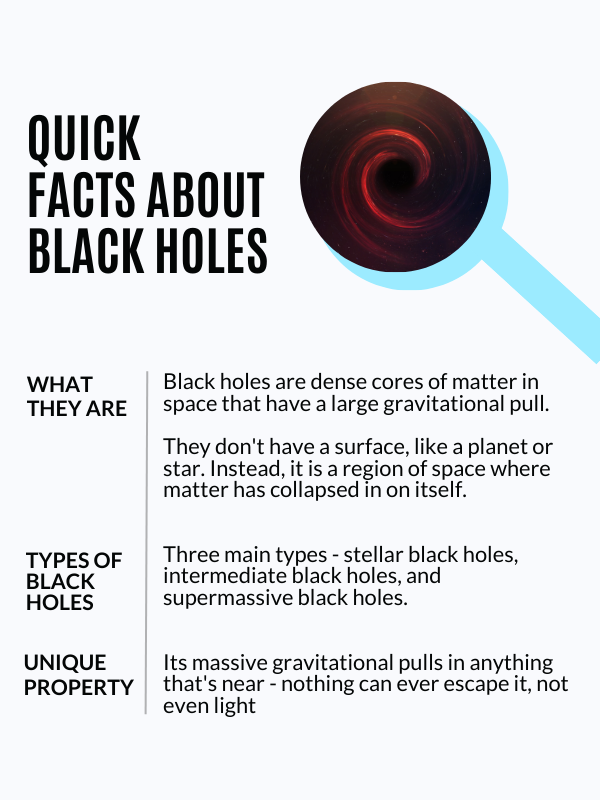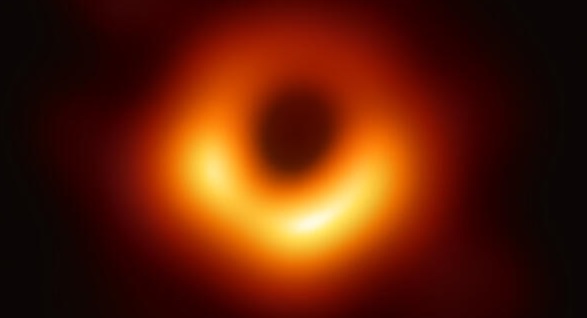Top Amazing Fun Facts About Black Holes In 2023
Written by Sthitee Mohanty, senior writer.
Can the Earth fall into a black hole?
Written by Sthitee Mohanty, senior writer.
Here’s what you need to know about black holes..
A black hole is not really a hole and not exactly black!

Black holes have intrigued astronomers and astrophysicists for a long time. But, what are they? Why are they so mysterious?
Let’s read on to know more about black holes.
What is a Black Hole?

A black hole is a large amount of matter packed compactly into a very small area. It is a very dense concentration of mass that forms a super strong gravitational field that can even swallow stars!
That’s right, black holes ‘swallow’ things.
Like every celestial body, they have a gravitational field of influence. Any object that comes into contact with this field is sucked into the black hole, and thus it appears that the black hole has eaten the object.
The black holes draw in dust and gases from their surrounding space (including gases!), growing in size. Not even light can escape black holes. How do we know where black holes are then? Read on to learn more fun facts about black holes.
A black hole is formed when a star dies. When a star about three times the mass of the sun dies, it forms a black hole. As the star collapses, matter compresses and a black hole is formed.
A neutron star/white dwarf is formed only when a star with a mass less than three times the mass of the sun collapses.
How does a star die?
- A star dies when it runs out of nuclear fuel – yes, stars run on nuclear energy. Nuclear fusion reactions happen in its core, keeping it ‘alive’.
- A star goes supernova before it dies – its outer layers explode.
- Tinier the star, the slower it burns its fuel. So large stars die out relatively quickly.
- Depending on its mass, a dying star forms either a neutron star or a black hole.
After recent observations, scientists believe that a black hole has a layered structure. It has two basic layers – the event horizon and the singularity.
The event horizon can be further divided into the inner and outer layers. Once an object passes through the event horizon, it cannot escape the gravitational pull of the black hole.
The singularity is the dark centre of the black hole. The entire mass of the black hole is concentrated at this point.
Black holes cannot be seen. Do you know why? It is because they do not reflect light – light is pulled into the centre and is not allowed to reflect.
So how do we observe these bodies? By paying attention to their surroundings! Scientists gather a lot of information on black holes by observing the gases, dust, stars, etc, around black holes. The radiations black holes emit also help in this.
So black holes are literally known by the company they keep! Black holes are being studied by a huge range of scientists, from astrophysicists to quantum physicists. Research is released frequently, suggesting newer information about black holes.
Go further down for some fun facts about black holes.
Top 20 Fun Facts About Black Hole In 2023

1. Black holes can eat each other as well. Supermassive black holes can merge with stellar black holes or other supermassive black holes they collide with.
2. Black holes continue to fascinate the science fiction community. Numerous books and movies have worked with this concept. Watch Christopher Nolan’s movie Interstellar to learn more fun facts about black holes!
3. The black hole’s gravity causes bodies to elongate, giving rise to ‘spaghettification’. This means that anything that gets pulled in becomes long in shape – like spaghetti!
4. Physicists Stephen Hawking and Kip Thorne had an ongoing bet on the first discovered black hole Cygnus X-1! Hawking had bet against it being a black hole, only to be proven wrong later.
5. It was once thought that black holes could last forever! Current research states that black holes disappear after some time.
6. Black holes aren’t exactly black! They’re just the visible effects of black holes. We can only see the matter black holes pull into themselves!
7. Research suggests that a black hole cannot consume the whole Universe.
8. The Milky Way has a black hole at its centre. Sagittarius A* (Sgr A*) is a supermassive black hole present at its centre, too far away to pose any danger to Earth.
9. A black hole can tear apart any star that comes into its gravitational influence!
10. The black hole closest to Earth is Gaia BH1! It is 1,600 lightyears away!
11. Black holes can generate energy more efficiently than the sun. And here’s what’s interesting – while black holes swallow up everything, even light – they also give out light in the form of energy called jets that get propelled into space, forming lines of glowing segments!
12. When a group of stars (known as star clusters) collapse, they often form a supermassive black hole.
13. Black holes can evaporate – this was predicted by Stephen Hawking! Called Hawking radiation, a black hole disappears after radiating energy into space.
14. Black holes can merge and form bigger black holes.
15. The Earth cannot be swallowed by a black hole! Black holes only eat up what’s very close to them. All the black holes are very far away and if our sun was to die and turn into a black hole, the earth would not fall in, as it is very far away from the sun!
16. Disney released a movie called “The Black Hole” in 1979. It got an Oscar nomination for best visual effects!
17. Black holes spin – a leftover motion from their parent stars!
18. Black holes produce static noise – they do weird things to particles near their centre, even accelerating them so much that these particle vibrations produce noise!
19. Black holes cannot be seen. We know about them by seeing the discs of material that swirl around them – these are very hot and give off X-rays.
20. A supermassive black hole has a mass that’s more than that of 1 million suns together!
have masses of more than that one million suns together!
Where are Black Holes Found?

Black holes are hard to track, but astronomers believe that black holes, especially supermassive ones, are found at the centre of almost all large galaxies, including our Milky Way.
The Milky Way is said to contain over 100 million black holes! Not hard to imagine, what with the supermassive black hole Sagittarius A* at its centre!
And here’s the thing – black holes cannot be directly observed by telescopes. Scientists observe surrounding space to gather information on black holes. Black holes interact with matter near them by either releasing or absorbing an amount of energy that instruments on Earth can record. This energy can be gamma rays, X-rays, etc.
The Event Horizon Telescope captured the first image of a black hole in 2019. It was a supermassive black hole in the centre of a galaxy called the Messier 87!

Did you know that the nature of a black hole affects where a black hole is found?
Types of black holes

Black holes are differentiated based on their mass.
Different types may have different causes of formation – nothing can be said for sure because scientists have no firm idea of how certain types are formed.
The existence of three types of black holes has been confirmed: stellar black holes; intermediate black holes; supermassive black holes.
Stellar black holes are the smallest black holes (relative to the other discovered types) formed by the collapse of individual stars. It is easier to find these black holes because they occur near another star.
Intermediate black holes are said to be the missing link between stellar and supermassive black holes. Though many have been identified, scientists struggle to confirm them as intermediate black holes.
Supermassive black holes are giants. They are the most common type in space now. These black holes are way heavier than the sun of our solar system – almost a billion times!
A fourth black hole type’s existence has been theorised by scientists– the primordial black hole. It has remained undetected. Many believe that it was formed during the beginning of the universe, hence naming it “primordial” arising from the Latin word “primordium” which means original.
How is the mass of a black hole measured?
- A black hole does not have infinite mass
- Though we can’t see black holes, we can see what surrounds them. By measuring the orbiting speed of stars surrounding the black hole, we can find out its mass!
- Even the laws of gravity are used – gravity is a universal force that exists even in space!
Who discovered Black Holes?

The discovery of black holes has two parts to it – some scientists believed in their existence as early as the 18th century. However, evidence of their existence was discovered only in recent times.
Both mathematics and physics are involved in its discovery, for both fields unite in the study of black holes!
In 1783, John Mitchell was the first to predict the existence of black holes.
Albert Einstein’s general theory of relativity further helped in the discovery of black holes. During World War I, German physicist Karl Schwarzschile mathematically proved the existence of black holes by solving Einstein’s equations. He also made predictions regarding their behaviour.
What is Einstein’s General Theory of Relativity?
Einstein’s relativity theory involves the force of gravity, the mass of a body, and the speed of light.
It can be boiled down to a simple equation: E = mc^2
Do you not recognise the iconic equation above? That is the mathematical representation of his theory.
The relativity theory, simply put, explains what happens to the mass of an object when it has a velocity equal to the velocity of light.
Light travels at an approximate speed of 3 X 10^9 metres per second. In a body travelling at the speed of light, its mass will be converted into energy.
It was only in 1967, that American astronomer John Wheeler came up with the term “black hole” – a term we use today.
The first black hole to be identified was the Cygnus-X-1 black hole. Three people independently declared its discovery: Louise Webster and Paul Murdin, and Thomas Bolton predicted this black hole’s existence by observing a blue star’s orbit over 6000 light years away.
This was a quick introduction to black holes. Hope you found it useful.

Better Your Child’s G.K. In 3 Minutes – Get This Free Newsletter
Get fun facts, simple and easy news, quizzes, and lots of other interesting things to read in your mailbox – for free! It’s what we call GK-on-the-go!
I Kid You Not now has a large readership across India and also parts of the world. If you want to write for us, you can submit your story here. You can also apply to become a news anchor. Apply here



Comments